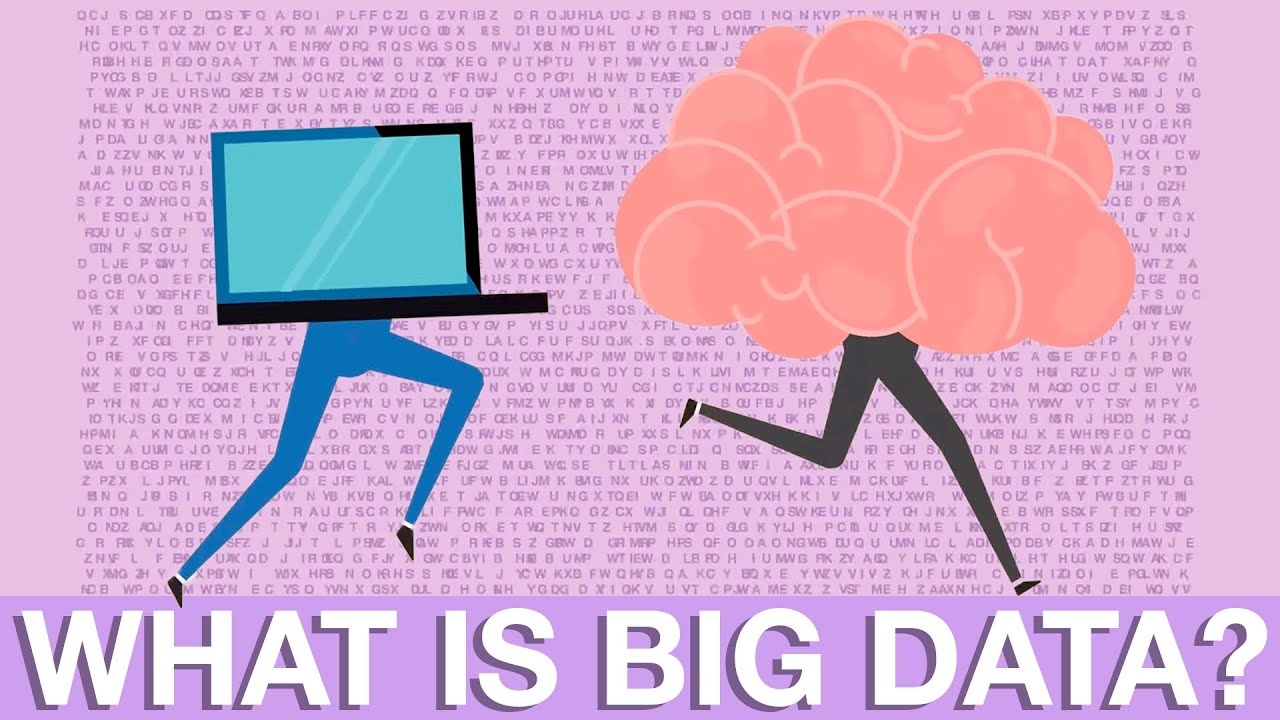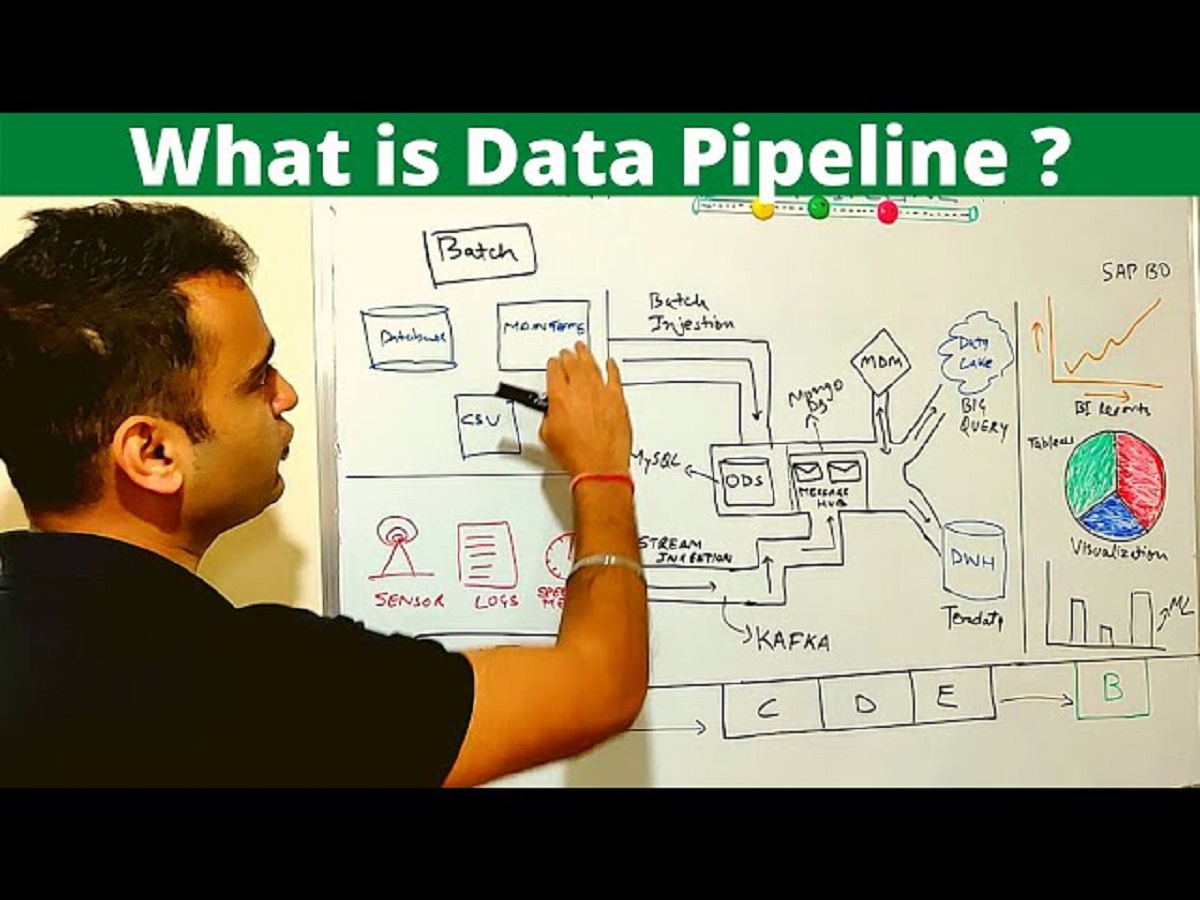Introduction
When it comes to processing and analyzing massive volumes of data, ETL (Extract, Transform, Load) tools play a crucial role in the success of big data projects. ETL tools are specifically designed to facilitate the extraction of data from various sources, transforming it into a usable format, and loading it into a target destination. These tools enable organizations to streamline their data pipelines and ensure accurate and timely data processing.
In the world of big data, where the volume, velocity, and variety of data are ever-increasing, choosing the right ETL tool becomes paramount. The right tool can significantly impact the efficiency, scalability, and performance of your data processing workflows. With a wide array of ETL tools available in the market, selecting the best one for big data projects can be challenging.
This article aims to guide you through the process of choosing the best ETL tool for big data. We will outline the criteria that should be considered when making your decision and provide an overview of some of the top ETL tools available today.
Before we dive into the details, let’s first understand the importance of ETL in big data processing. By seamlessly extracting, transforming, and loading data, ETL tools enable organizations to unlock the full potential of their big data by making it accessible and actionable.
What is ETL?
ETL stands for Extract, Transform, Load – a process used in data integration and management to move and manipulate data from various sources into a target system or database. The primary purpose of ETL is to ensure data quality, consistency, and availability for analysis and reporting.
The first stage of the ETL process is extraction, where data is gathered from different sources, such as databases, spreadsheets, files, and APIs. This includes identifying the relevant data fields, tables, and records that need to be extracted for further processing.
Once the extraction is complete, the next stage is transformation. Data needs to be transformed to align with the target system’s data model, structure, and business rules. This involves data cleansing, validation, aggregation, normalization, and enrichment. During this stage, any inconsistencies, errors, or duplicates are resolved, and data is formatted to meet specific requirements.
Finally, the transformed data is loaded into the target system or database. This can be a data warehouse, a business intelligence tool, a reporting system, or any other destination where the data will be used for analysis, decision-making, or operational purposes.
ETL processes are critical for businesses because they enable data-driven insights, decision making, and automation. By centralizing data from multiple sources and ensuring its quality and consistency, organizations can gain a holistic view of their operations, customers, and market trends.
While the concept of ETL has been around for decades, its importance has grown exponentially in the era of big data. With the exponential growth of data, organizations need robust ETL processes and tools to handle the complexity and volume of data they collect and generate.
ETL tools have evolved to not only handle structured data but also semi-structured and unstructured data, such as social media feeds, sensor data, and log files. They offer a range of features and capabilities, including data profiling, data governance, metadata management, data integration, and data lineage tracking.
In the next section, we will explore the importance of ETL in big data processing and the criteria to consider when choosing an ETL tool for big data projects.
Importance of ETL in Big Data Processing
As the volume, velocity, and variety of data continue to grow, organizations are faced with the challenge of efficiently processing and analyzing this vast amount of information. This is where ETL (Extract, Transform, Load) plays a crucial role in big data processing. Let’s explore why ETL is important in the context of big data.
Data Integration: Big data projects often involve collecting data from multiple sources, such as databases, cloud platforms, social media, IoT devices, and more. ETL tools enable organizations to integrate these disparate data sources into a unified and coherent format, making it easier to perform meaningful analysis and derive actionable insights.
Data Quality: Ensuring data quality is a key aspect of big data processing. ETL processes involve data cleansing, validation, and enrichment, which help improve the accuracy, consistency, and completeness of the data. By identifying and resolving data anomalies, errors, and inconsistencies during the transformation stage, ETL tools ensure that the resulting data is reliable and trustworthy.
Data Transformation: Big data often comes in various formats and structures. ETL tools facilitate the transformation of data from its raw form into a format that is suitable for analysis and reporting. This includes aggregating, filtering, normalizing, and converting data so that it aligns with the target system’s requirements and business rules.
Data Scalability: Big data processing involves handling massive volumes of data in a distributed and parallelized manner. ETL tools are designed to scale horizontally, allowing organizations to process large datasets efficiently. By leveraging the parallel processing capabilities of ETL tools, organizations can significantly reduce the time and resources required for data processing.
Data Governance and Compliance: With the increasing emphasis on data governance and compliance, organizations must have control and visibility over their data. ETL tools provide features for data lineage tracking, metadata management, and access control, ensuring that data is handled in a compliant and secure manner.
Data Agility: As business needs and requirements change, organizations need the flexibility to adapt their data processes quickly. ETL tools that offer visual interfaces, drag-and-drop capabilities, and code generation features enable data engineers and analysts to build and modify data pipelines with ease. This agility allows organizations to respond to new insights, trends, and business challenges in a timely manner.
Data Insights and Decision-Making: Ultimately, the goal of big data processing is to gain valuable insights for making informed decisions. ETL tools streamline the data preparation and integration process, allowing data analysts and data scientists to focus on generating insights and performing advanced analytics. By providing clean, integrated, and ready-to-use data, ETL tools accelerate the time-to-insights and enable data-driven decision-making.
Considering the significance of ETL in big data processing, it is essential to carefully choose the right ETL tool that aligns with your organization’s requirements and capabilities. In the next section, we will discuss the criteria to consider when selecting an ETL tool for big data projects.
Criteria to Consider When Choosing an ETL Tool for Big Data
Choosing the right ETL tool for big data projects is a critical decision that can impact the efficiency, scalability, and success of your data processing workflows. To make an informed choice, there are several criteria that should be considered. Let’s explore the key factors to consider when selecting an ETL tool for big data processing.
Scalability: Big data projects involve processing and analyzing massive volumes of data. It is crucial to choose an ETL tool that can handle the scale and velocity of data processing. Look for tools that offer distributed processing capabilities and can scale horizontally to accommodate growing data volumes.
Data Integration Capabilities: Consider the flexibility and ease of integrating data from various sources. Look for ETL tools that can extract data from a wide range of sources, including databases, cloud platforms, APIs, and streaming data. The tool should also offer support for both structured and unstructured data formats.
Data Transformation and Manipulation: Evaluate the tool’s transformation capabilities. It should support a wide range of data transformation functions such as aggregation, filtering, joins, pivoting, and data cleansing. Additionally, consider the tool’s support for complex data manipulation tasks, such as handling nested data structures or performing advanced analytics.
Data Quality and Governance: Data quality is crucial for reliable analysis and decision-making. Look for ETL tools that offer data profiling and validation features to ensure data accuracy. Consider tools that provide data lineage tracking, metadata management, and data governance capabilities to maintain data integrity and compliance with regulations.
Performance and Speed: Processing big data requires efficient and high-speed operations. Evaluate the performance capabilities of the ETL tool, such as parallel processing, in-memory computing, and caching mechanisms. Look for tools that can optimize data processing workflows to minimize latency and maximize throughput.
Usability and Flexibility: Consider the ease of use and flexibility of the ETL tool. Look for tools that offer visual interfaces, intuitive workflows, and drag-and-drop functionalities. The tool should provide flexibility in handling changing data requirements and allow for easy modification of data pipelines.
Integration with Big Data Ecosystem: Consider the compatibility of the ETL tool with your existing big data ecosystem. It should seamlessly integrate with other tools and technologies such as Hadoop, Spark, and cloud platforms. Look for ETL tools that offer connectors and plugins to easily connect with the various components of your big data infrastructure.
Support and Community: Evaluate the vendor’s support and community resources. Look for tools that have active user communities, documentation, tutorials, and forums. Consider the availability of technical support, updates, and bug fixes to ensure smooth operations and timely issue resolution.
Cost and Licensing: Finally, consider the cost and licensing model of the ETL tool. Evaluate the pricing structure, whether it is based on a subscription, usage, or perpetual license. Consider the total cost of ownership, including upfront costs, maintenance fees, and any additional costs for add-ons or integrations.
By considering these criteria and aligning them with your organization’s specific needs and requirements, you can choose the ETL tool that best fits your big data processing workflows. In the next section, we will explore some of the top ETL tools available for big data projects.
Top ETL Tools for Big Data
Choosing the right ETL tool is crucial for effective big data processing. To help you in your decision-making process, we have compiled a list of some of the top ETL tools available for big data projects. These tools offer a range of features, scalability, and flexibility to meet the complex data processing requirements of organizations dealing with large volumes of data.
1. Apache Nifi: Apache Nifi is an open-source data integration tool that provides a visual interface and powerful data transformation capabilities. It offers support for complex data flows, including real-time streaming, and can easily integrate with different data sources and destination systems.
2. Talend: Talend is a widely used open-source ETL tool that offers a comprehensive suite of data integration and management solutions. It provides a user-friendly graphical interface, supports big data technologies such as Hadoop and Spark, and offers extensive connectivity options for various data sources.
3. Informatica PowerCenter Big Data Edition: Informatica PowerCenter Big Data Edition is a robust ETL tool that enables organizations to process and integrate large volumes of structured and unstructured data. It offers advanced data transformation capabilities, native support for Hadoop and Spark, and features for data quality and governance.
4. IBM InfoSphere DataStage: IBM InfoSphere DataStage is a powerful ETL tool that provides scalability, data integration, and transformation capabilities. It supports parallel and distributed processing, offers connectivity to various data sources, and seamlessly integrates with IBM’s big data ecosystem.
5. Microsoft Azure Data Factory: Azure Data Factory is a cloud-based ETL service offered by Microsoft. It enables organizations to orchestrate and automate data workflows across various data sources, including on-premises and cloud databases. It integrates well with other Azure services, providing scalability and flexibility.
6. Apache Kafka: While not a traditional ETL tool, Apache Kafka is a widely used distributed streaming platform that can be leveraged for real-time data ingestion, transformation, and processing. It offers high throughput and fault-tolerant messaging, making it suitable for streaming data pipelines in big data environments.
7. Google Cloud Dataprep: Google Cloud Dataprep is a cloud-based data preparation tool that offers visual data wrangling capabilities. It enables organizations to clean, transform, and enrich large volumes of data, including big data, with an intuitive interface and pre-built features for data profiling and exploration.
8. AWS Glue: AWS Glue is an ETL service provided by Amazon Web Services (AWS) that simplifies the process of data extraction, transformation, and loading. It offers serverless ETL capabilities, automates schema discovery, and integrates well with other AWS services, making it a popular choice for big data projects on AWS.
9. Pentaho Data Integration: Pentaho Data Integration, also known as Kettle, is an open-source ETL tool that offers a wide range of data integration and transformation capabilities. It supports big data technologies, provides a visual interface for designing data pipelines, and offers features for data quality, governance, and analytics.
10. Apache Spark: Apache Spark, while not specifically an ETL tool, is a powerful distributed computing framework that can be utilized for big data processing and transformation. It offers in-memory processing, supports real-time streaming, and provides APIs for data manipulation, making it a popular choice for ETL-like workflows in big data environments.
These are just a few examples of the top ETL tools available for big data processing. It is essential to evaluate your specific requirements and consider factors such as scalability, flexibility, ease of use, and compatibility with your existing data infrastructure. By selecting the right ETL tool, you can streamline your big data processing workflows and unlock the full potential of your data.
Apache Nifi
Apache Nifi is an open-source data integration tool that provides a powerful platform for designing and executing data flows. It offers a user-friendly web-based interface that allows users to build, monitor, and manage data pipelines effectively. With its visual interface and drag-and-drop functionality, Apache Nifi simplifies the complexity of data integration tasks in big data environments.
One of the key features of Apache Nifi is its ability to handle real-time streaming data. It supports data ingestion from various sources such as databases, IoT devices, social media platforms, and more. This makes it an ideal choice for organizations that need to process and analyze high-velocity data streams.
Apache Nifi offers a wide range of built-in processors, which are the core components used to perform data transformation and manipulation. These processors can transform data, route it based on conditions, enrich it with additional information, and perform various other operations. Additionally, Apache Nifi allows users to extend its functionality by creating custom processors to meet specific business requirements.
Another significant advantage of Apache Nifi is its scalability. It is designed to handle large volumes of data and can be deployed in a distributed manner across multiple nodes. This allows organizations to scale their data processing capabilities as their data volumes and processing needs grow.
Furthermore, Apache Nifi provides robust security features to ensure data protection and privacy. It offers authentication, authorization, and encryption mechanisms to secure data in transit and at rest. This is particularly important in big data environments, where data privacy and compliance with regulatory requirements are paramount.
Apache Nifi integrates well with other big data technologies, such as Apache Kafka, Apache Hadoop, and Apache Spark. It provides connectors and processors to interact with these systems, enabling seamless data integration and processing within the big data ecosystem.
Overall, Apache Nifi is a versatile and powerful ETL tool for big data processing. Its visual interface, real-time streaming capabilities, scalability, and security features make it a popular choice for organizations dealing with complex data integration requirements. With its active community and continuous development, Apache Nifi continues to evolve and innovate to meet the ever-growing demands of big data processing.
Talend
Talend is a widely recognized open-source ETL tool that offers comprehensive data integration and management solutions. With its intuitive user interface and extensive feature set, Talend has gained popularity among organizations looking to streamline their big data processing workflows.
One of the key strengths of Talend is its ability to handle complex data integration tasks. It provides a wide range of connectors and adapters that enable seamless integration with various data sources, including databases, cloud platforms, APIs, and more. Whether it’s structured, semi-structured, or unstructured data, Talend can handle it all.
Talend offers a graphical interface that allows users to visually design data pipelines using a drag-and-drop approach. This makes it easy to design, monitor, and manage data integration processes without the need for extensive coding or scripting. It also provides a unified development environment that supports collaboration, version control, and reuse of components.
With its powerful transformation capabilities, Talend allows users to cleanse, enrich, and transform data according to their specific needs. It offers a rich set of built-in functions and operators, as well as the flexibility to create custom transformations using Java, SQL, or scripting languages like Python or JavaScript.
Talend supports big data technologies such as Apache Hadoop and Apache Spark, enabling users to process large volumes of data efficiently. It leverages the distributed processing capabilities of these frameworks, allowing for scalability and high performance in big data environments.
Data quality is a critical aspect of big data processing, and Talend takes it seriously. It provides features for data profiling, validation, and cleansing, ensuring that the data being processed is accurate, consistent, and reliable. It also offers data governance capabilities, facilitating compliance with regulations and governing data access and usage.
Furthermore, Talend offers comprehensive support for data management tasks, such as metadata management, data lineage tracking, and data cataloging. These features provide visibility and control over the entire data integration process, enhancing data governance and facilitating collaboration across teams.
Lastly, Talend has a robust and active community of users, who contribute to its continuous development and improvement. It provides extensive documentation, tutorials, and forums where users can seek assistance and share best practices.
In summary, Talend is a powerful ETL tool that offers extensive capabilities for data integration, transformation, and management. Its intuitive graphical interface, support for big data technologies, and focus on data quality make it a popular choice for organizations seeking to streamline their big data processing workflows and derive valuable insights from their data.
Informatica PowerCenter Big Data Edition
Informatica PowerCenter Big Data Edition is a robust ETL tool specifically designed for big data processing and integration. It offers a comprehensive set of features and capabilities that enable organizations to handle large volumes of data and derive valuable insights.
One of the key strengths of Informatica PowerCenter Big Data Edition is its scalability. It is built to handle the massive scale of big data, enabling organizations to process and integrate data from various sources efficiently. It supports distributed processing and parallel execution, allowing for high-performance data processing even in complex big data environments.
Informatica PowerCenter Big Data Edition provides advanced data transformation capabilities. It offers a wide range of pre-built transformation functions and operators, allowing users to cleanse, transform, and enrich the data as needed. It also supports complex data transformations, such as aggregations, pivoting, and handling nested data structures, providing flexibility in data processing workflows.
The tool integrates seamlessly with various big data technologies, such as Hadoop, Spark, and NoSQL databases, allowing organizations to leverage their existing big data infrastructure. It provides native connectivity and optimization for these platforms, ensuring efficient data processing and integration.
Data quality is a crucial aspect of big data processing, and Informatica PowerCenter Big Data Edition offers robust features to ensure data accuracy and reliability. It provides data profiling capabilities that help identify data quality issues, allowing users to perform data cleansing and validation tasks. Additionally, it offers data governance functionalities, enabling organizations to enforce data policies, maintain data lineage, and ensure compliance with data regulations.
Informatica PowerCenter Big Data Edition also offers extensive support for metadata management. It allows users to define and manage data definitions, transformations, and mappings, providing visibility and traceability across the data integration process. This enhances data governance, improves collaboration, and facilitates data lineage tracking.
Furthermore, Informatica PowerCenter Big Data Edition provides robust security features to protect sensitive data. It offers authentication, access control, encryption, and data masking capabilities, ensuring data privacy and compliance with data security regulations.
Informatica PowerCenter Big Data Edition has a comprehensive ecosystem of additional tools and extensions that can enhance its functionality. These tools include Informatica Data Quality, Data Integration Hub, and Informatica Enterprise Data Catalog, providing organizations with a holistic data management and integration solution.
In summary, Informatica PowerCenter Big Data Edition is a powerful and feature-rich ETL tool designed for big data processing. Its scalability, advanced transformation capabilities, seamless integration with big data technologies, data quality and governance features, and comprehensive ecosystem make it a top choice for organizations looking to harness the power of big data and derive meaningful insights.
IBM InfoSphere DataStage
IBM InfoSphere DataStage is a powerful ETL tool designed to handle complex data integration and transformation tasks in big data environments. It offers a comprehensive set of features and capabilities that enable organizations to process and manage large volumes of data efficiently.
One of the key strengths of IBM InfoSphere DataStage is its scalability. It is built to handle the high volume and velocity of big data. It offers parallel processing capabilities, allowing for efficient data integration and transformation across distributed systems. This scalability enables organizations to meet the growing demands of their data processing needs.
IBM InfoSphere DataStage provides an extensive array of built-in connectors and adapters that facilitate seamless integration with various data sources, including databases, cloud platforms, and enterprise applications. It supports data extraction, transformation, and loading from both structured and unstructured data sources, giving organizations the flexibility to process different types of data.
The tool offers a visual interface that allows users to design and manage data integration workflows easily. With its drag-and-drop functionality and intuitive workflow design, users can create data pipelines, define transformations, and orchestrate complex data integration processes without the need for extensive coding or scripting.
IBM InfoSphere DataStage provides a wide range of data transformation capabilities. It offers a comprehensive set of transformation functions, operators, and rules that enable users to cleanse, filter, aggregate, and transform the data as required. It also supports advanced transformations, such as data enrichment, data masking, and complex data mapping, providing users with the flexibility to handle diverse data processing needs.
Data quality is a crucial aspect of big data processing, and IBM InfoSphere DataStage offers robust features to ensure data accuracy and consistency. It provides data profiling capabilities that help identify data quality issues, allowing users to cleanse and validate the data effectively. It also supports data quality rules, data lineage tracking, and data governance mechanisms, enhancing overall data integrity.
IBM InfoSphere DataStage seamlessly integrates with other IBM products and technologies, such as IBM Netezza, IBM Db2, and IBM Watson, providing a complete end-to-end data integration and analytics solution. It leverages the power of these technologies to enhance data processing speed, scalability, and analytics capabilities.
Furthermore, IBM InfoSphere DataStage offers comprehensive scheduling, monitoring, and management capabilities. It provides an intuitive user interface for managing data integration workflows, monitoring job status, and diagnosing and resolving issues. It also offers extensive logging and auditing features, facilitating compliance and providing visibility into data processing activities.
In summary, IBM InfoSphere DataStage is a robust and scalable ETL tool specifically designed for big data processing. With its extensive connectivity options, visual interface, advanced transformation capabilities, and integration with other IBM technologies, it provides organizations with a powerful solution to handle their complex data integration and transformation needs.
Microsoft Azure Data Factory
Microsoft Azure Data Factory is a cloud-based ETL service that enables organizations to orchestrate and automate data workflows at scale. It offers a comprehensive set of features and capabilities that make it a popular choice for big data processing and integration in the Azure ecosystem.
One of the key strengths of Azure Data Factory is its seamless integration with various data sources and services within the Azure platform. It provides a wide range of connectors for popular data sources such as Azure Blob Storage, Azure SQL Database, and Azure Data Lake Storage. It also offers connectors for external data sources and supports various data formats, making it flexible for diverse integration needs.
Azure Data Factory provides a visual interface that allows users to visually design and construct data pipelines using a no-code or low-code approach. With its intuitive drag-and-drop functionality, users can easily build complex data workflows and schedule data integration tasks. It also offers template-based pipeline creation, facilitating the reuse and standardization of data integration pipelines.
Scalability is a key aspect of big data processing, and Azure Data Factory offers native scalability features. It can dynamically scale resources based on demand, ensuring efficient data processing and reducing costs. The horizontal scalability allows organizations to handle large volumes of data and processing requirements without the need for manual intervention.
Azure Data Factory supports data transformation and manipulation through a combination of built-in activities and custom code options. It provides a rich set of data transformation activities such as data conversion, filtering, joining, and aggregating data. It also allows users to incorporate custom code using Azure Functions or Azure Databricks for complex transformations and advanced analytics.
The service offers extensive monitoring and management capabilities. Users can monitor data pipeline execution, track the status of individual activities, and troubleshoot errors through detailed logging and metrics. Azure Data Factory also integrates with Azure Monitor, enabling users to set up alerts and notifications for critical events.
Security is a top priority in Azure Data Factory. It offers robust identity and access management mechanisms through Azure Active Directory. Users can control access to data sources, encrypt data in transit and at rest, and enforce data protection policies. Azure Data Factory complies with industry standards and regulations, ensuring data security and compliance for organizations.
Additionally, Azure Data Factory integrates seamlessly with other Azure services, such as Azure Databricks, Azure Machine Learning, and Azure Synapse Analytics. This allows organizations to leverage the power of these services for advanced analytics, machine learning, and data warehousing, further enhancing their data processing capabilities.
In summary, Microsoft Azure Data Factory is a powerful and scalable ETL service for big data processing in the Azure environment. With its ease of use, seamless integration, scalability, security, and integration with other Azure services, it provides organizations with a comprehensive solution for orchestrating and automating their data workflows in the cloud.
Apache Kafka
Apache Kafka is a distributed streaming platform that can be leveraged for real-time data ingestion, transformation, and processing. While not a traditional ETL tool, Apache Kafka has become popular for building data pipelines in big data environments due to its high-throughput, fault-tolerant messaging system.
One of the key strengths of Apache Kafka is its ability to handle high volumes of streaming data. It provides a publish-subscribe messaging model, allowing data producers to publish data to Kafka topics, and data consumers to subscribe to these topics and process the data in real-time. This makes it well-suited for streaming data scenarios, where data needs to be ingested and processed as it arrives.
Apache Kafka offers horizontal scalability and fault-tolerance by distributing data across multiple nodes in a cluster. This enables high-throughput data processing and ensures data availability even in the event of node failures. Companies dealing with high data volumes and requiring low-latency data processing can benefit from Kafka’s ability to handle complex data ingestion and processing workloads efficiently.
Data can be transformed within Apache Kafka using Kafka Streams, a lightweight and scalable stream processing library that is part of the Apache Kafka ecosystem. Kafka Streams allows users to perform real-time data transformations, aggregations, filtering, and joins directly within the Kafka cluster, eliminating the need for additional ETL tools in some cases.
Apache Kafka integrates well with other big data technologies and systems. It can act as a data source or a data sink for various tools and frameworks, including Hadoop, Spark, and relational databases. This makes it a versatile component in a big data processing pipeline, enabling seamless data integration and processing across the entire data ecosystem.
The durability and fault-tolerance in Apache Kafka are achieved through a distributed commit log architecture. Data is persisted on disk, allowing for reliable data storage and replayability of events. This, combined with its high throughput, makes Kafka suitable for real-time analytics, event-driven architectures, log aggregation, and continuous data streaming scenarios.
Apache Kafka provides strong data durability and supports different messaging guarantees, such as at most once, at least once, and exactly once semantic. This ensures data integrity and consistency during data processing, making it reliable for mission-critical applications that require strict data delivery guarantees.
In summary, Apache Kafka is a robust distributed streaming platform that provides high-throughput, fault-tolerant messaging and real-time data processing capabilities. While it is not a traditional ETL tool, it serves as a key component in big data processing pipelines, enabling efficient data ingestion, transformation, and processing at scale. Its integration capabilities, durability, and fault-tolerance make it a valuable choice for organizations dealing with high volumes of streaming data and requiring real-time data processing and analytics.
Google Cloud Dataprep
Google Cloud Dataprep is a cloud-based data preparation tool that offers powerful data wrangling capabilities for big data processing. It enables organizations to clean, transform, and enrich their data to make it ready for analysis and downstream processing.
One of the key strengths of Google Cloud Dataprep is its intuitive and user-friendly interface. It provides a visual data preparation environment where users can easily explore, clean, and transform their data without the need for coding or complex scripting. The tool offers a range of pre-built data transformations and functions that can be applied through a simple point-and-click interface.
Google Cloud Dataprep supports a wide range of data sources and formats. It integrates seamlessly with Google Cloud Storage, Google BigQuery, and other data storage systems, making it easy to connect and access data. It also supports various file formats, including CSV, JSON, Avro, and Parquet, allowing organizations to work with diverse data sources.
The tool provides powerful data transformation capabilities. It offers features like data profiling, data type inference, and automatic column formatting to assist users in understanding their data. Users can perform various transformations such as cleaning, filtering, aggregating, and joining data to prepare it for downstream analytics or integration.
Google Cloud Dataprep leverages machine learning algorithms to assist users in data wrangling tasks. It can automatically detect patterns, suggest data transformations, and anticipate user actions based on historical data preparation tasks. This helps streamline the data preparation process and reduces the time and effort required for manual data cleaning and transformation.
Data quality is a critical aspect of data preparation, and Google Cloud Dataprep offers features to ensure data accuracy and consistency. The tool allows users to profile and analyze data quality issues such as missing values, duplicates, and inconsistent data, helping them identify and resolve data quality problems effectively.
Google Cloud Dataprep also offers collaboration capabilities, allowing multiple users to work together on data preparation tasks. Users can share data preparation recipes, workflows, and results with their team members, facilitating collaboration and streamlining the data preparation process.
Integration with other Google Cloud services is another notable feature of Google Cloud Dataprep. Users can seamlessly integrate their data preparation workflows with Google Cloud Dataflow for large-scale data processing, Google BigQuery for data storage and analytics, and other Google Cloud services for end-to-end data processing pipelines.
In summary, Google Cloud Dataprep is a powerful data preparation tool for big data processing. With its intuitive interface, powerful data wrangling capabilities, machine learning assistance, and seamless integration with other Google Cloud services, it enables organizations to transform and prepare their data for analysis and downstream processing efficiently.
AWS Glue
AWS Glue is a fully managed extract, transform, and load (ETL) service provided by Amazon Web Services (AWS). It simplifies the process of data extraction, transformation, and loading, making it easier for organizations to build scalable and cost-effective data integration pipelines.
One of the key strengths of AWS Glue is its serverless architecture. It automatically provisions and scales the required compute resources based on the size and complexity of the data processing tasks. This eliminates the need for manual infrastructure management, allowing organizations to focus on their data integration logic.
AWS Glue offers a visual interface that enables users to define and manage their data transformation workflows easily. It provides an easy-to-use graphical environment for creating and organizing data extraction, transformation, and loading steps. Users can visually map the source and target data structures, define transformations using a variety of built-in functions, and preview the transformed data.
The service supports a wide range of data sources, including Amazon S3, Amazon RDS, Amazon Redshift, and various on-premises data stores. It provides connectors and built-in data classifiers that simplify the process of accessing, discovering, and cataloging data from multiple sources.
With AWS Glue, users can automatically discover the schema and data structure of their source datasets. The service analyzes the data and generates a unified metadata catalog, which can be used to understand the data lineage, perform data quality checks, and generate source-to-target mappings. This metadata catalog can also be shared across different data integration workflows and applications.
Integration with other AWS services is seamless in AWS Glue. Users can effortlessly leverage services such as AWS Lambda, Amazon Athena, Amazon EMR, and AWS Step Functions as part of their ETL pipelines. This enables organizations to incorporate advanced data processing, analytics, and orchestration capabilities into their data integration workflows.
AWS Glue supports both batch and real-time data processing scenarios. It allows users to schedule and automate data extraction and transformation on a recurring basis or in response to specific events. In addition, it provides capabilities for streaming data processing using Apache Kafka and Amazon Kinesis Data Streams, enabling real-time data integration and analysis.
Data security and compliance are top priorities in AWS Glue. It provides encryption at rest and in transit, as well as integration with AWS Identity and Access Management (IAM) for fine-grained access control. Organizations can also enforce data governance policies through integration with AWS Lake Formation or by utilizing AWS Glue’s native data cataloging and data classification capabilities.
In summary, AWS Glue is a powerful and scalable ETL service that simplifies data integration and transformation tasks. With its serverless architecture, visual interface, support for various data sources, metadata cataloging capabilities, and tight integration with other AWS services, it enables organizations to build robust and efficient data integration pipelines in the AWS ecosystem.
Pentaho Data Integration
Pentaho Data Integration, also known as Kettle, is a powerful open-source ETL tool that provides a comprehensive set of features for data integration, transformation, and processing. It offers a robust and flexible platform to efficiently handle big data processing and build data pipelines.
One of the key strengths of Pentaho Data Integration is its versatility. It supports various data sources, including databases, cloud platforms, files, and big data technologies. This flexibility allows organizations to seamlessly integrate and process data from different sources, regardless of the data format or structure.
With its intuitive visual development environment, Pentaho Data Integration simplifies the process of building data integration workflows. It provides a drag-and-drop interface for designing data pipelines, where users can easily define transformations, connections, and job schedules. This visual approach reduces the need for coding and speeds up the development process.
Pentaho Data Integration offers a rich set of transformation capabilities. It provides a wide range of pre-built transformations and functions that users can leverage to clean, filter, aggregate, and transform the data. Additionally, it supports custom transformations, allowing users to write their own code or utilize external libraries for advanced data manipulation.
The tool integrates seamlessly with big data technologies such as Apache Hadoop, Apache Spark, and NoSQL databases. Users can leverage the power of these technologies for distributed data processing, analytics, and storage. Pentaho Data Integration provides connectors and plugins for these platforms, enabling organizations to utilize their existing big data infrastructure.
Data quality is a crucial aspect of data integration, and Pentaho Data Integration offers features to ensure data accuracy and consistency. It provides built-in data profiling, cleansing, and validation capabilities that help identify and address data quality issues. Users can define data quality rules, perform duplicate checks, and monitor data quality metrics as part of their data processing workflows.
Pentaho Data Integration includes extensive logging, monitoring, and error handling capabilities. Users can track the execution of data pipelines, view real-time metrics, and analyze logs for troubleshooting purposes. It also provides alerting mechanisms to notify users of any errors or issues encountered during data integration processes.
The tool offers extensive support for metadata management. It allows users to define and manage metadata, data dictionaries, and data lineage. This helps organizations ensure data governance, data lineage tracking, and comply with data compliance regulations in their data integration processes.
Pentaho Data Integration has an active and vibrant community, which contributes to its continuous improvement and development. Users can access a wealth of resources, including documentation, forums, and best practices, which can be valuable for troubleshooting issues and expanding their knowledge.
In summary, Pentaho Data Integration is a versatile and powerful ETL tool for big data processing. With its visual interface, extensive transformation capabilities, integration with big data technologies, data quality features, metadata management support, and vibrant community, it provides organizations with a comprehensive solution for effective data integration and processing.
Apache Spark
Apache Spark is a powerful distributed computing framework that is widely used for big data processing, including extract, transform, and load (ETL) tasks. Although not traditionally an ETL tool, Apache Spark provides a high-performance and scalable platform for processing and transforming large volumes of data efficiently.
One of the key strengths of Apache Spark is its ability to handle large-scale data processing. It can distribute data and computation across multiple nodes in a cluster, allowing for parallel processing and increased performance. This scalability makes it suitable for handling big data workloads with ease.
Apache Spark provides extensive transformation capabilities through its Spark SQL, DataFrame, and Dataset APIs. These APIs enable users to perform complex data transformations, aggregations, filtering, and joins on large datasets using a familiar SQL-like syntax or functional programming paradigms. This flexibility allows users to express their data transformation logic effectively.
The in-memory computing capability of Apache Spark allows for fast and iterative data processing. By keeping data in memory, Spark avoids unnecessary disk I/O operations, resulting in significantly improved performance. This is particularly beneficial for iterative algorithms, machine learning models, and real-time data processing scenarios.
Apache Spark integrates well with various data sources, including structured databases, semi-structured files, and streaming data sources. It provides connectors for popular data storage systems and formats, such as Apache Hadoop, Amazon S3, Apache Parquet, and Apache Avro. This makes it easy to integrate Spark into existing data ecosystems and leverage its processing capabilities.
Spark Streaming is a component of Apache Spark that supports real-time data ingestion and processing. It allows users to process streaming data in near real-time, enabling real-time analytics, monitoring, and alerting. With its fault-tolerant processing model, Spark Streaming ensures data reliability and consistency during continuous data processing.
Apache Spark provides machine learning libraries, such as MLlib and SparkML, which offer a wide range of algorithms and tools for scalable machine learning workflows. This integration enables users to perform data transformation, feature engineering, model training, and prediction within the Spark ecosystem, eliminating the need for separate libraries or frameworks.
In addition to its core capabilities, Spark offers support for graph processing through its GraphX API. This allows users to perform graph computations, such as graph analytics and graph algorithms, on large-scale graph datasets. With its parallel processing capabilities, Spark can analyze and traverse massive graphs efficiently.
Apache Spark supports various programming languages, including Scala, Java, Python, and R. This flexibility allows users to leverage their existing programming skills and preferences. Additionally, Spark provides interactive shells and notebooks for different languages, enabling users to explore and prototype data processing workflows easily.
In summary, Apache Spark is a versatile and powerful distributed computing framework that excels in big data processing and transformation. With its scalability, in-memory computing, integration with various data sources, real-time processing capabilities, machine learning support, and language flexibility, Apache Spark provides organizations with a comprehensive platform for efficient and scalable ETL tasks.
Conclusion
Choosing the right ETL tool for big data projects is paramount to ensure efficient and accurate data processing. The selection process should consider factors such as scalability, data integration capabilities, transformation features, data quality and governance, performance, usability, compatibility with existing infrastructure, support, and cost.
Apache Nifi offers a user-friendly interface and real-time streaming capabilities, making it suitable for organizations dealing with high-velocity data. Talend, an open-source ETL tool, provides extensive data integration and transformation capabilities, while Informatica PowerCenter Big Data Edition offers scalability and advanced features for complex big data processing.
IBM InfoSphere DataStage excels in scalability and seamless integration with IBM’s big data ecosystem, while Microsoft Azure Data Factory provides a cloud-based ETL service with seamless integration in the Azure environment. Apache Kafka, although not a traditional ETL tool, is widely used for real-time data ingestion and processing in streaming scenarios.
Google Cloud Dataprep simplifies data preparation tasks with its easy-to-use interface, and AWS Glue offers a serverless ETL service with seamless integration with other AWS services. Pentaho Data Integration provides a versatile open-source solution, and Apache Spark excels in distributed computing and big data processing.
In conclusion, selecting the best ETL tool for big data processing requires careful consideration of the organization’s specific requirements and preferences. Each tool mentioned has its own strengths and features, so the choice should align with the organization’s data processing needs, existing infrastructure, and data governance requirements. By selecting the right ETL tool, organizations can optimize their data integration workflows and unlock the full potential of their big data.

























